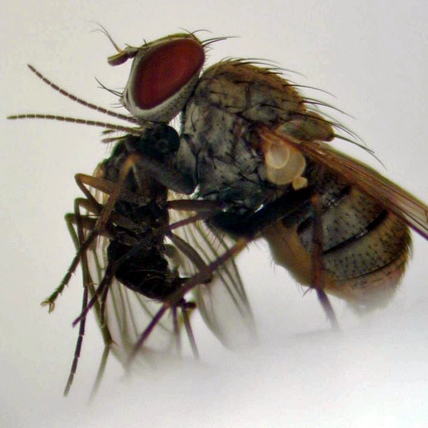
Photo provided by Kochi University’s Laboratory of Insect Ecology shows a hunter fly eating a mushroom fly.
Laboratory of Insect Ecology at Kochi University’s Faculty of Agriculture in Nankoku, Kochi Prefecture, has developed, for the first time in the world, a method to propagate Coenosia attenuate, commonly called “hunter flies,” a natural enemy which catches flying insect pests.
Adult hunter flies catch and eat such insects as whiteflies, leafminer flies and mushroom flies. The laboratory believes the predator can be a promising biocontrol agent at horticulture facilities and facilities that grow mushrooms on beds of compost.

Prof. Ryo Arakawa of Kochi University in Nankoku, Kochi Prefecture, shows a mesh fabric cage where hunter flies are kept.
Hunter flies were first discovered in Japan in 2005 by a farmer in the village of Geisei in Kochi inside a greenhouse growing green peppers. Receiving a report that a fly is eating adult whiteflies, Prof. Ryo Arakawa visited the farm half in doubt, and saw a fly smaller than house flies catching a flying whitefly and eating it atop a green pepper leaf.
The laboratory conducted research to develop a method to propagate hunter flies and found that the flies can mate inside a 30-cubic-centimeter mesh fabric cage and can feed on fruit flies which are easy to breed. Baby hunter flies can be raised on a fibrous medium, feeding on shrimp eggs.
The laboratory is planning to conduct an experiment of releasing hunter flies in cultivation facilities to find out the effective timing and amount of release for pest control of whiteflies and leafminer flies that cause damage to greenhouse-grown eggplants, green peppers and cucumbers.
Arakawa says hunter flies can become useful like other natural enemies used widely in Kochi Prefecture, including Nesidiocoris tenuis and Pilophorus typicus, species of predatory mirid bugs.
(April 15, 2015)

